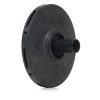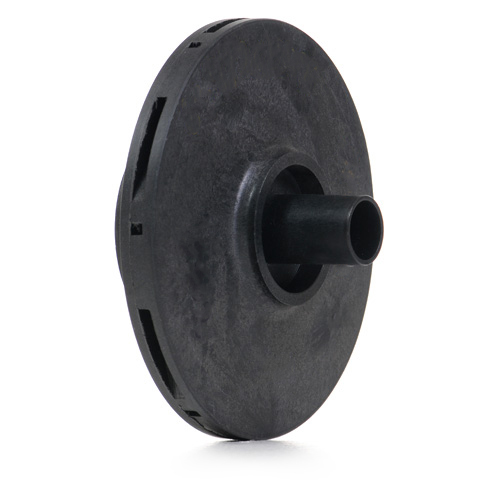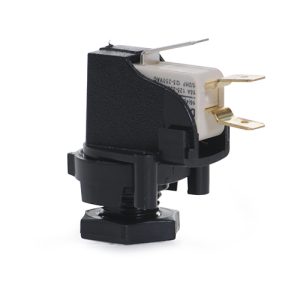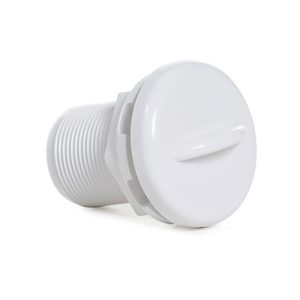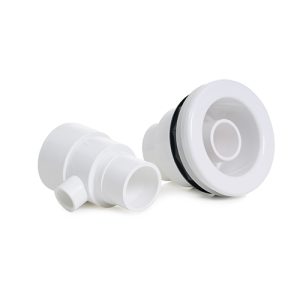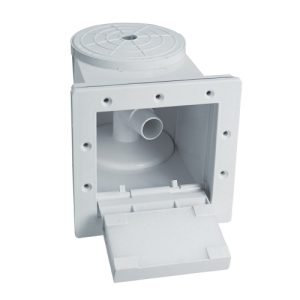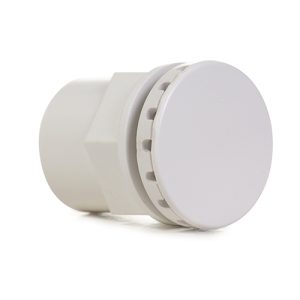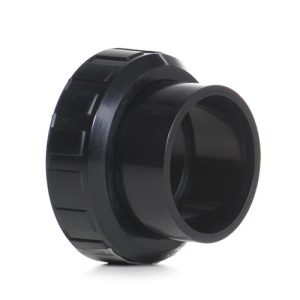Aquamite Pump 0.33hp Impellor
£66.98 Inc VAT
Out of stock
Want to be notified when this product is back in stock?
Aquamite Pump 0.33hp Impeller
Replacement Circulation Component for Compact Pumps
As a retailer of pool and spa parts, I stock this genuine replacement impeller specifically for Aquamite 0.33hp pumps. The impeller is the heart of your pump’s hydraulic system, and this correctly sized component ensures optimal water flow and efficient circulation for smaller pools and spas.
What is a Pump Impeller?
The impeller is a rotating disc with curved vanes or blades that spins inside the pump housing, driven by the motor shaft. As it rotates at approximately 3,450 revolutions per minute, it creates centrifugal force that moves water through your pool or spa circulation system. This is the component that actually does the work of moving water—everything else in the pump supports this primary function.
For 0.33hp motors, the impeller is sized smaller than those used on higher horsepower pumps. The vane design, diameter, and blade angles are precisely engineered to match the motor’s power output, ensuring efficient water movement without overloading the motor or wasting energy.
How the 0.33hp Impeller Works
When the motor spins the impeller, water enters through the center (the impeller eye) and is immediately caught by the curved vanes. Centrifugal force throws this water outward toward the edges at high velocity, creating low pressure at the center that extends back through the suction plumbing to the pool.
This low-pressure area allows atmospheric pressure to push water from the pool through the skimmers and drains, into the pump. Meanwhile, water thrown to the impeller’s outer edge is captured by the pump volute (the spiral housing) which converts velocity into pressure, forcing water through the filter and back to the pool.
The 0.33hp impeller is designed for lower flow rates appropriate to smaller pools, spas, or water features. While it moves less water than larger impellers, it does so efficiently within the power constraints of the 0.33hp motor, providing adequate circulation without excessive energy consumption.
Signs Your Impeller Needs Replacement
Reduced water flow is the primary symptom—if return jets are weaker than normal or filter pressure has dropped significantly, the impeller may be damaged or worn. Even partial vane breakage noticeably reduces pump performance.
Unusual noises including grinding, rattling, or vibration often indicate impeller problems. Broken vane pieces rattling inside the housing create distinctive sounds, while an unbalanced impeller from partial damage causes vibration throughout the pump.
If the pump loses prime frequently (starts pumping air instead of water), a damaged impeller may be unable to generate sufficient suction. Cracks or broken vanes allow water to recirculate internally rather than being pushed through the system.
Cavitation noise—a sound like gravel flowing through the pump—can result from impeller damage that disrupts smooth water flow. This creates vapor bubbles that collapse violently, producing the characteristic noise while eroding pump components.
Visible damage when inspecting the impeller shows obvious problems: broken or chipped vanes, cracks in the impeller body, or severe wear on the vane edges all require replacement.
Common Causes of Impeller Damage
Debris is the leading cause of impeller failure. Small stones, twigs, toys, or other objects that bypass the strainer basket can jam between impeller vanes or chip the edges. Even seemingly harmless debris causes damage when struck at 3,450 rpm.
Running the pump dry generates extreme heat that can warp or melt plastic impellers. Without water for cooling and lubrication, temperatures inside the pump housing rise rapidly, damaging the impeller and potentially the seal and other components.
Chemical imbalance accelerates impeller degradation. Water consistently outside proper pH ranges (especially acidic conditions below 7.0) corrodes impellers over time. The aggressive water chemistry literally dissolves material from the vanes, weakening them until they break.
Cavitation—vapor bubble formation and collapse—erodes impeller surfaces through repeated microscopic impacts. This typically results from suction-side restrictions like clogged skimmers, undersized plumbing, or excessive pump height above water level.
Age and normal wear eventually take their toll. Even without dramatic damage, years of continuous operation gradually wear the vane edges and surfaces, reducing hydraulic efficiency until performance drops noticeably.
Importance of Correct Impeller Size
Using the correctly sized impeller for your 0.33hp motor is critical. An oversized impeller (designed for higher horsepower motors) overloads the motor, causing it to draw excessive current, overheat, and potentially fail. The motor simply cannot spin a larger impeller at proper speed under load.
An undersized impeller won’t provide adequate water flow for effective pool circulation. While the motor handles the load easily, the pump cannot move enough water to maintain proper filtration and chemical distribution.
The 0.33hp impeller is specifically designed to match this motor’s torque and speed characteristics, providing optimal flow while operating within the motor’s safe operating envelope. This balance ensures efficient performance and long equipment life.
Installation Considerations
Installing a new impeller requires disassembling the pump to access the impeller housing. The impeller threads onto the motor shaft—most impellers have left-hand threads (tighten counterclockwise) to prevent the impeller from unscrewing during operation.
Check impeller clearance after installation. The gap between the impeller back shroud and the diffuser should typically be 0.010 to 0.030 inches. This critical spacing ensures efficient operation—too much clearance allows internal recirculation that reduces flow; too little causes friction and potential contact damage.
Use brass shims on the motor shaft to adjust clearance if needed. Adding shims moves the impeller away from the diffuser; removing shims brings it closer. Proper clearance maximizes efficiency and prevents premature wear.
Inspect the mechanical seal during impeller replacement. If the impeller failed due to debris damage, the seal may also be compromised. Many technicians replace both components simultaneously to avoid reopening the pump shortly after reassembly.
Protecting Your New Impeller
Maintain clean strainer baskets—empty them at least twice weekly during heavy use. This simple maintenance prevents most debris-related impeller damage by catching foreign objects before they reach the impeller.
Never run the pump dry. Always ensure the pump basket is filled with water before starting, and shut down immediately if you hear the pump labouring or notice reduced water flow that might indicate air in the system.
Maintain proper water chemistry with pH between 7.2 and 7.8. Balanced water minimizes corrosive attack on the impeller material, extending its service life significantly.
Address suction-side restrictions promptly. Keep skimmers clear, ensure adequate water level, and verify plumbing is properly sized. Eliminating restrictions prevents cavitation damage to the new impeller.
Compatibility
This impeller is specifically engineered for Aquamite 0.33hp pumps. The dimensions, vane design, and hydraulic characteristics match this pump’s specifications. Using the correct impeller ensures proper performance, motor loading, and system efficiency.
The Aquamite 0.33hp pump is ideal for smaller pools, spas, and water features where compact size and lower flow rates are advantageous. This makes the impeller a commonly needed replacement part for these installations.
Product Specifications
| Specification | Details |
|---|---|
| Product Type | Pump Impeller |
| Compatibility | Aquamite 0.33hp pumps |
| Motor Size | 0.33 horsepower |
| Function | Water circulation via centrifugal force |
| Application | Small pools, spas, water features |
| Material | Engineered plastic (chemical-resistant) |
| Mounting | Threads onto pump motor shaft |
| Weight | 0.13 kg |
| Dimensions (L × W × H) | 0.1 m × 0.15 m × 0.15 m |
| Volume | 0.002 cubic meters |
| SKU | 6497240190 |
| Category | Pool & Spa Spares |
Preventive Maintenance Tips
Listen to your pump during operation. Changes in sound—new rattles, grinding, or changes in pitch—can indicate developing impeller problems. Early detection allows replacement before complete failure or additional damage occurs.
Monitor pump performance through regular checks of return jet strength and filter pressure. Gradual performance decline often indicates impeller wear before dramatic failure occurs.
During annual pump opening or winterization, visually inspect the impeller if possible. Look for chips, cracks, or excessive wear that suggest replacement should be scheduled.
Keep spare impellers on hand for critical installations where downtime is unacceptable. Having the correct replacement available eliminates delays waiting for parts delivery.
This essential hydraulic component restores your Aquamite 0.33hp pump to proper operation, ensuring adequate water circulation for effective filtration and chemical distribution in your pool or spa system.
| Weight | 0.13 Kilograms |
|---|---|
| Length | 0.1 Meters |
| Width | 0.15 Meters |
| Height | 0.15 Meters |
| Volume | 0.002 CubicMeters |
| Supplier | GoldenC |
Related products
Spares
Spares
Spares

